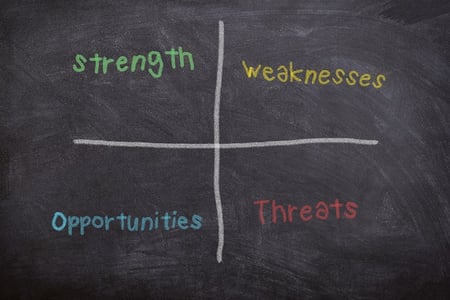Index Content
SWOT analysis, also known as SWOT analysis, is a well-known technique used by most companies to analyse their internal situation (strengths and weaknesses) and their external situation (threats and opportunities). The objective is to know the real situation of the business in order to gain an advantage over competitors.
Internal analysis
- Strengths: For the internal analysis it is necessary to consider the positive factors that an organisation has to generate an advantage over its competitors.
- Weaknesses: With the elements, energy resources, skills and attitudes of an organisation, it is possible to determine the barriers it has to achieve positive results. This can also include elements related to finance, market, organisation and control. Finally, after identifying the weaknesses of the organisation, it is necessary to carry out a strategy to immediately eliminate the internal problems.
External analysis
- Opportunities are a series of positive and favourable factors for the organisation. It is important to know what they are in order to take advantage of them and provide positive factors for the brand. There are several points to consider in this section:
-Circumstances that can improve the organisation's situation.
- Market opportunities that can be beneficial.
- Technology-related developments in the market.
-Changes in legal/policy regulations.
- Strengths. Negative situations linked to the project that may harm its operation. To solve this circumstance, it is essential to design an appropriate strategy. To do so, as a strategy manager, you must keep in mind some concepts, such as:
-Obstacles faced by the company.
-The actions and campaigns being developed by the competition.
-The possible existence of budget problems.
-The performance and engagement of market rivals.

how to do a good SWOT analysis?
- strategy building: To execute this analysis in your organisation, you first need to make a plan. You need to recognise the external and internal characteristics and factors of your organisation.
- matching and conversion: This second step consists of finding the competitive advantage over competitors by bringing together the organisation's strengths and opportunities. It is also possible to convert weaknesses or threats into opportunities and strengths in order to take advantage of them in the market.
- finally, marketing managers in organisations should use the SWOT analysis to study the strengths and weaknesses of the competition. They study a multitude of factors: cost structure of each competitor, sources of profit, resources, competitive positioning and product differentiation, among others.

why is a SWOT analysis so important?
The importance of using a SWOT analysis lies in the fact that this process allows us to proactively and systematically search for and analyse all the variables involved in the business in order to have more and better information when making decisions.
Although the ideal strategic tool for setting out the mission, vision, goals, objectives and strategies of a company is the Business Plan or Marketing Plan, by carrying out a SWOT analysis correctly, it is possible to establish all the types of strategies necessary to meet the business objectives set out.
3 examples of SWOT analysis
- sWOT analysis of Zara. Zara's weaknesses in the SWOT matrix include its lack of variety in standard and large sizes, its marketing in traditional media, its non-exclusive designs and complaints about its staff. Its threats are a saturated and highly competitive industry, rising taxes and prices, and the economic crisis. The Spanish brand has positioned itself in the textile industry through its fast fashion business model, in which it constantly renews its offer. It is present in over eighty countries and has adapted to foreign markets with very competitive prices. If it aims to open up new horizons it could do so with products such as cosmetics, sportswear, take advantage of e-commerce and create alliances.
- SWOT analysis of Sony: Sony's SWOT analysis reveals that, despite the financial setbacks it has suffered, it remains a company that offers high quality products and therefore has a loyal customer base, although in recent years it has not managed to position itself adequately in the mobile phone market, nor has it developed its marketing and customer service to the same level as its competitors.
- sWOT analysis of Zoom. During the health contingency, the use of video calls through Zoom was a simple and effective solution to the communication problems that arose, in addition to being a free access alternative. Its popularity was affected when some users reported constant crashes and saturation, and denounced "Zoobombing", in which unknown users hacked meetings, putting the privacy and security of participants (and the information they share) at risk. Within the SWOT analysis of the platform we observe that it can counteract the drop in demand and outperform its competitors by strengthening the cybersecurity of meetings; either by establishing alliances with antivirus applications, updating its software or instructing users to avoid attacks through phishing.





